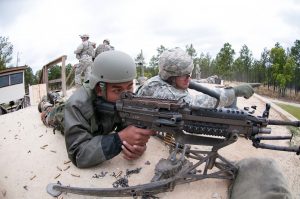The latest edition of the annual exercises between the Indian and U.S. armies kicked off on February 8 at the Mahajan Field Firing Ranges in Rajasthan, a western Indian state bordering Pakistan. The 16th edition of the Yudh Abhyas exercises, which will continue until February 21, will – like past iterations – focus on counterterrorism and promote interoperability between the two forces, according to the Indian Army.
India and the United States began army exercises in 2004. A U.S. army description of the goals of the Yudh Abhyas series notes: “Execution of these exercises is vital to effective and efficient peacekeeping and foreign disaster relief operations and civil affairs core tasks focused on humanitarian and disaster relief.”
According to a statement by defense spokesperson Lt. Col. Amitabh Sharma, as quoted by the Press Trust of India, “Exercise with U.S. Army is significant in terms of security challenges faced by both the nations in the backdrop of global terrorism. The joint military exercise will enhance the level of defence cooperation between both armies which will also foster the bilateral relations between both nations and reiterate India’s key role as a key partner in the Indo-Pacific region.”
The latest iteration of the Yudh Abhyas exercises is the third time Indian and U.S. militaries have exercised together in the last four months, highlighting the growing depth of the bilateral defense relationship. In November last year, the United States’ and Indian naval ships – along with those of Australia’s and Japan’s – participated in the annual Malabar exercise in the Indian Ocean, following which the anti-submarine warfare Sea Dragon exercise in Guam also saw the participation of the two (along with, again, Australia and Japan, but also Canada) last month. Along with single-service exercises as well as a one involving special forces from both countries, the two also held a first ever tri-service exercise, Tiger Triumph, in November 2019.
According to Sharma, the 2021 Yudh Abhyas (Hindi for “war practice”) will see the Indian army fielding troops from the 11th Battalion of Jammu and Kashmir Rifles. The United States army will be represented by 2nd Battalion of the 3rd Infantry Regiment of 1-2 Stryker Brigade Combat Team, according to Sharma.
A U.S. Embassy, New Delhi, statement, providing additional details, has noted that the exercises will involve around 250 soldiers from each side. Pointing to the format of the exercises, it said that along with “expert academic exchanges and professional development workshops that focus on training at the corps-level and below,” they will feature a command post exercise (CPX) and a field training exercise (FTX) to be held concurrently. The statement notes that the CPX will focus on United Nations-mandated peacekeeping missions, while the FTX will further “fundamental war-fighting skills to enhance combined operational capacity.”
India and the United States had agreed to jointly train U.N. peacekeepers from six African states in 2015.
While it is true that regular military-to-military engagements between India and the United States have significantly enhanced interoperability between forces, the two sides have still some way to go before they can function as a combined force in a regional contingency. Part of the problem — beyond a still-considerable gap in training, doctrines, and platforms and weapon systems operated by both sides — lies with the fact that when it comes to the United States, many in the Indian armed forces continue to be skeptical about the country’s strategic intent and attitude towards India. In a controversial Stimson Center study published last year, a former senior Defense Intelligence Agency officer Col. David Smith had noted that “a high level of mistrust (and thinly veiled hostility) about the United States generally persists in all three groups [senior, senior mid-level, and junior mid-level] of Indian officers.”

































